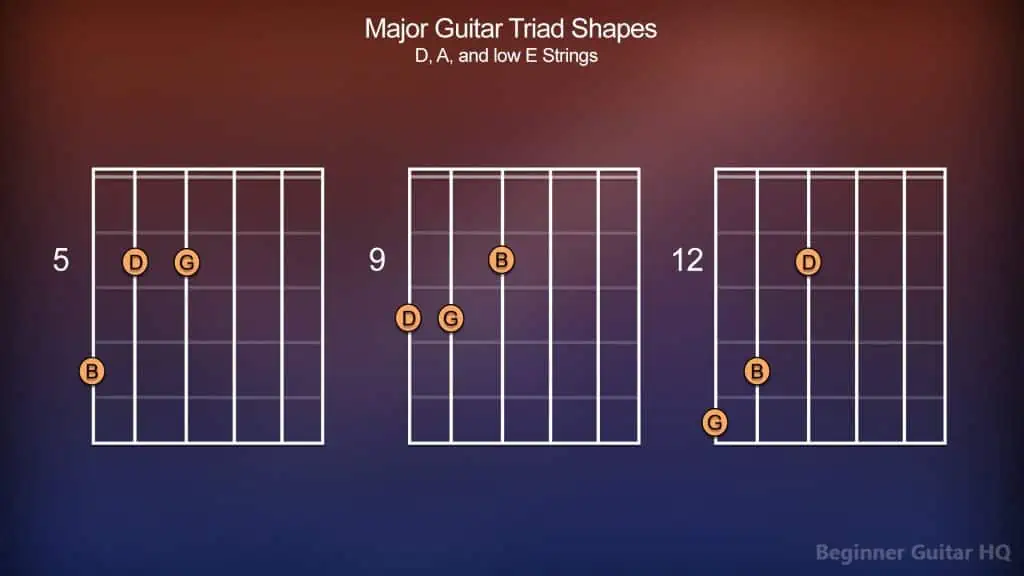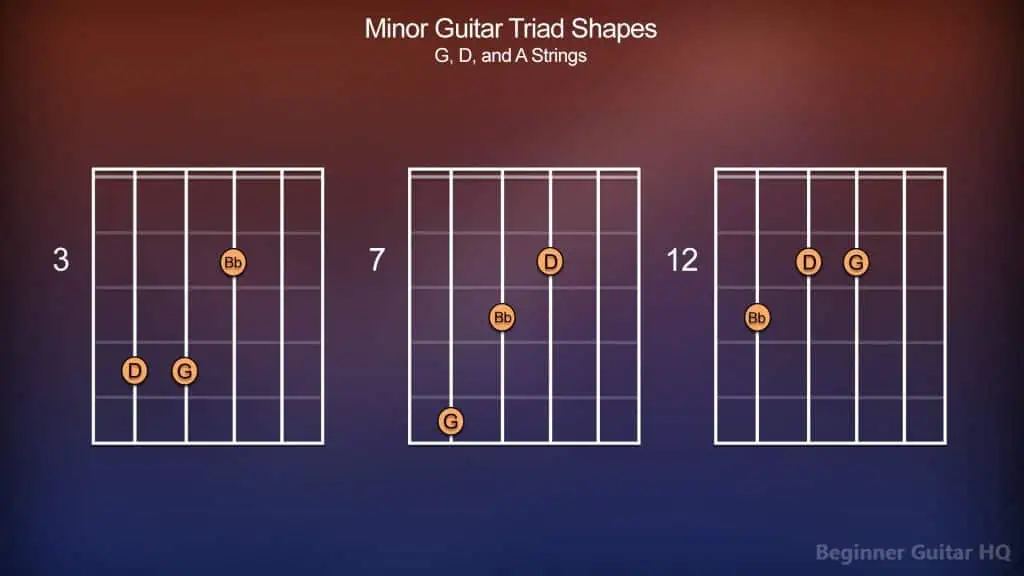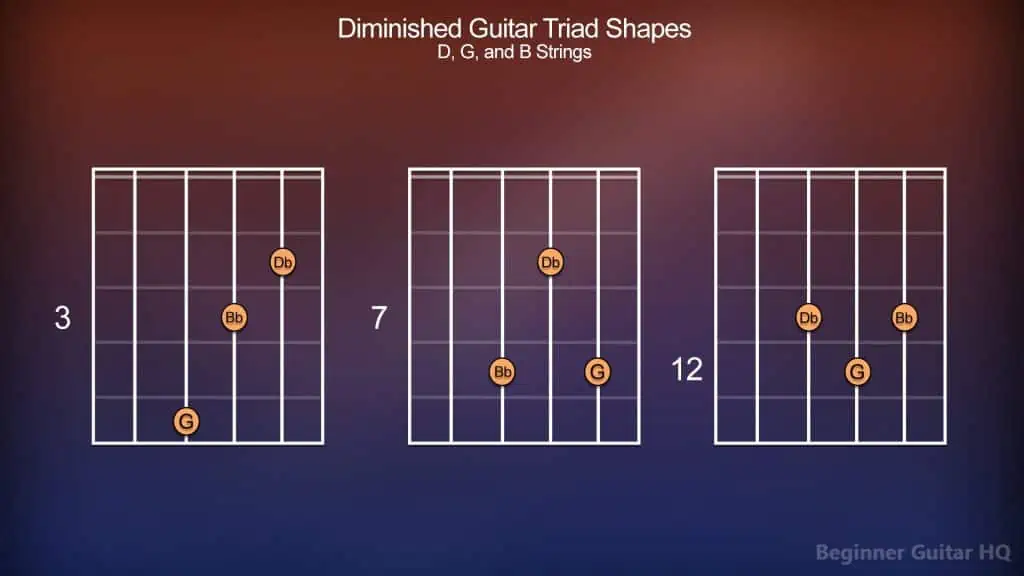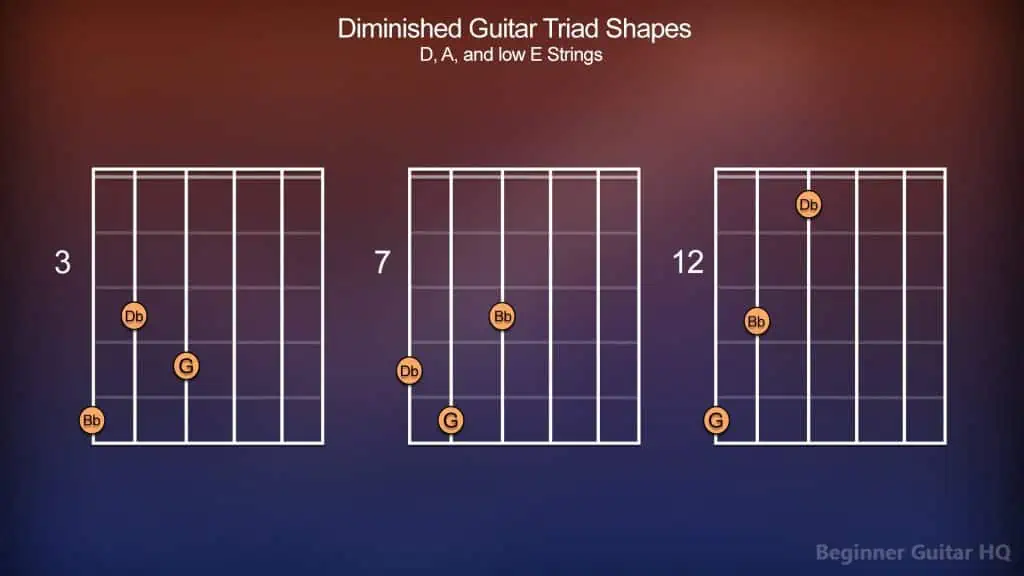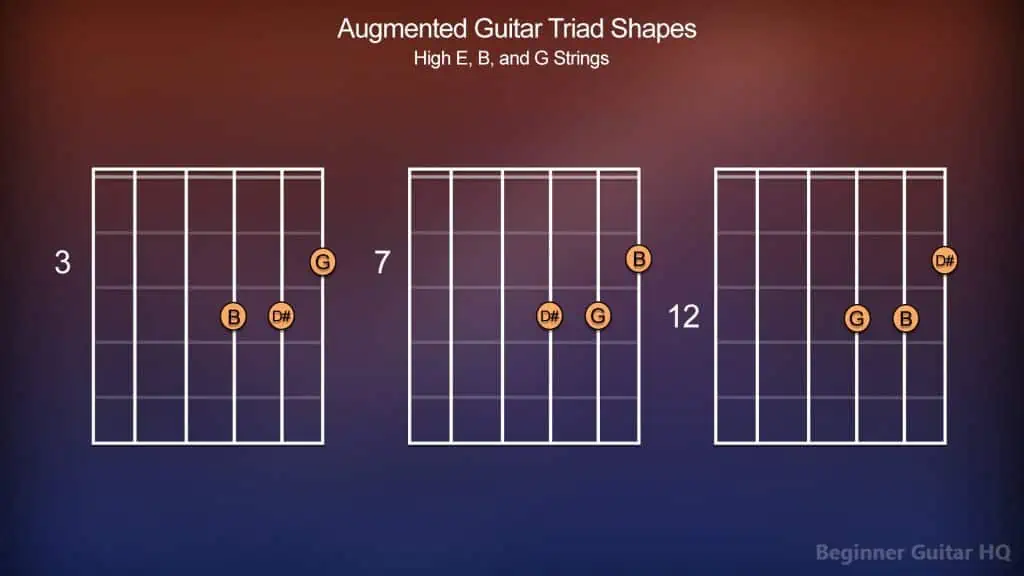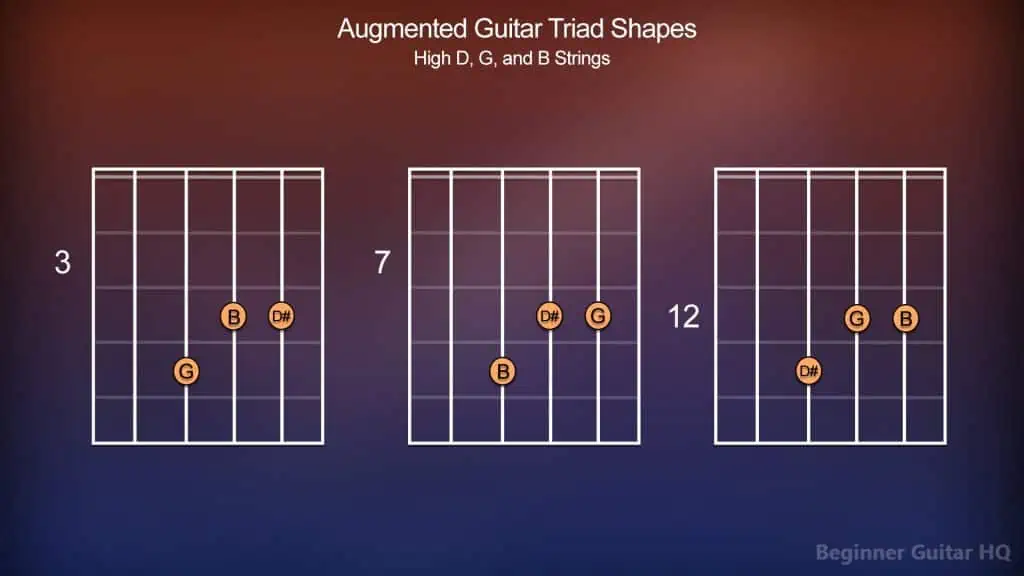Understanding how chords work, especially for guitar might feel somewhat overwhelming. However, look no further than your guitar triads for shedding some light on this mystery! Triads are a necessary component of many of our favorite and most commonly-used major and minor chords. In fact, you might say they not only lay the foundation for these chords, but other chords you might learn in the future! As you read on, we’ll cover all you need to know about triads and their various shapes, allowing you to put them to use right away. Let’s dive in!
What are Triads?
Chords are a fundamental feature of our stringed instruments, providing a slew of rich harmonies that add character and help convey a story or message within a song. A triad is a type of chord containing three notes played in harmony. The notes forming our triad are the tonic, mediant, and dominant notes of its associated scale.
It’s important to note, however, that there are different kinds of triads you might choose to play. However, for simplicities sake, we’ll go over these four kinds of triads:
- Major Triads
- Minor Triads
- Augmented Triads
- Diminished Triads
Major Triads
Beginning with our Major triads, for the purpose of this example, we’ll say that we’re in the key of D major. The first order of business is to figure out what the key signature of D major is. To figure this out quickly, it’s highly recommended to consult the “circle of fifths” for the answer. However, to save time, we’ll reveal the key of D major contains 2 sharps, F#, and C#. With this, we can throw together our D Major scale:
D > E > F# > G > A > B > C# > D
Each note within our scale has a unique role to play; these are known as our various scale degrees. Each degree has its unique name, allowing us to refer to them more easily when needed. Within the D major scale, these notes appear as:
D = Tonic (1st Degree)
E = Supertonic (2nd Degree)
F# = Mediant (3rd Degree)
G = Subdominant (4th Degree)
A = Dominant (5th Degree)
B = Submediant (6th Degree)
C# = Leading Tone (7th Degree)
D = Tonic (1st Degree/Octave)
Knowing our various scale degrees, in order for us to build a Major triad, we need to take the tonic, mediant, and dominant degrees of the scale (1st, 3rd, and 5th degrees), this could give us the notes: D, F#, and A, forming our D Major triad.
Major triads contain a particular set of intervals within their triads to give them their happy-sounding tone:
Major 3rd – Between the first and third notes. D > F#.
Minor 3rd – Between the third and fifth notes. F# > A.
Perfect 5th – Between the first and fifth notes. D > A.
Intervals such as these will be a common theme amongst our different triads, allowing us to distinguish the type of triad.
Minor Triads
Moving on, let’s go over our minor triads next. For this example, we’ll say that we’re in the key of Eb minor. Eb minor, as we know, has three flats in its key signature, Bb, Eb, and Ab. Let’s throw together our Eb minor scale:
Eb > F > G > Ab > Bb > C > D > Eb
Now, with this, we will once again be taking our tonic, mediant, and dominant degrees of the Eb minor scale, and stack them on top of each other. This will give us the triad of notes: Eb, G, and Bb.
Within a minor triad, we have a different composition of intervals, giving our minor triad its sad and melancholy vibe:
Minor 3rd – Between the first and third degrees. Eb > G.
Major 3rd – Between the third and fifth degrees. G > Bb.
Perfect 5th – Between the first and fifth degrees. Eb > Bb.
When compared to a major triad, can you spot the difference? You might have noticed that the first interval in a minor triad is a minor 3rd, while in a major triad, it’s a major 3rd. However, the second interval in a minor triad is a major 3rd, while in a major triad, it’s a minor 3rd. They’re reversed! The perfect 5th, however, remains the same in both.
Diminished Triads
Having gone through our minor triad, it only makes sense to talk about our diminished triad, also known as the “minor flatted fifth”. To start, we only need to grab a minor key; for this example, G# minor will work, containing five sharps: F#, C#, G#, D#, and A#. Let’s throw together our G# minor scale:
G# > A# > B > C# > D# > E > F# > G#
Once again, to form our triad, we’ll be taking the 1st, 3rd, and 5th degrees of our scale. This will give us the notes: G#, B, and D#. But wait! This time things are a little different. We’ll be taking our fifth degree, D#, and flattening it, making it a D note. This gives us the proper G# diminished triad of G#, B, and D.
As per usual, diminished triads have their own collection of intervals giving them their suspenseful and tense sound:
Minor 3rd – Between the first and third degrees. G# > B.
Minor 3rd – Between the third and fifth degrees. B > D.
Diminished 5th – Between the first and fifth degrees. G# > D.
Different from our aforementioned triads, we contain two of the same interval from the tonic. However, we don’t keep our perfect 5th interval this time, as our fifth degree is flattened, making it a diminished 5th.
Augmented Triads
Contrary to the diminished triad, our augmented triads contain major intervals. Therefore, for this example, we’ll be building an augmented triad in the key of A major. The key of A major contains three sharps, F#, C#, and G#. Let’s throw together our A major scale:
A > B > C# > D > E > F# > G# > A
To build an augmented triad, we’ll take the first, third, and fifth degrees of our A major scale. This will give us the notes: A, C#, and E. However, much in the way our diminished triads are, we’ll once again be altering the fifth note of our scale for this triad, instead by raising it by a semitone. Therefore, E will become E#, giving us the triad of notes: A, C#, and E#.
Our augmented triads have a very mysterious, and unsettling sound to them. Here are how our augmented triads are composed:
Major 3rd – Between the first and third degrees. A > C#.
Major 3rd – Between the third and fifth degrees. C# > E#.
Augmented 5th – Between the first and fifth degrees. A > E#.
Inversions
Inverted chords, otherwise known as inversions are an important part of triads. An inversion allows you to change the voicings of the different notes by flipping the triad on its head! Within a standard triad, there are two inversions. Using the C major triad as an example, here are the different inversions:
- Root Position – Exactly as it sounds! This is our triad in its truest form: C > E > G.
- 1st Inversion – Flipped on its head shifting our root note: E > G > C.
- 2nd Inversion – Flipped once more: G > C > E.
Inversions have a number of useful purposes, from creating a more interesting chord progression to modulating to a different key! The really great thing about inverting a chord is it doesn’t change the fundamental nature of the chord, as all of the notes are the same. It’s merely just the sequence of the notes that appear in the chord!
When you start getting into the territory of 7th, 9th, or even 11th chords, the number of inversions also increases, from 3rd, 4th, and even 5th inversions.
Triad Shapes
The process of learning triads on the guitar is a very simple one, requiring three fingers! The pattern of triad shapings on the neck remains consistent as you scale the neck, and as you’ll notice in each of these charts, we’ll be playing these triads in the key of G Major, and G minor.
Major Triads
Within the key of G Major, we have our notes: G, B, and D. As you notice in each of these triads, moving up the neck, our triad becomes inverted. Let’s go over how you can play each of these Major triads:
Major triad chord shapings on the high E, B, and G strings.
From the third fret, we’ll form a partial barre with our index finger, covering the G and D notes. Next, taking our middle finger, we’ll place it over the B note on the fourth fret.
From the seventh fret, we’ll take our middle finger, and place it over the B note, and we’ll place our index finger over the D note. Finally, we’ll take our ring finger, and place it over the G note on the eighth fret.
From the tenth fret, we’ll begin by placing our index finger on the D note. Following that, we’ll take our pinky finger and place it on the B note, and our ring finger on the G note of the twelfth fret.
Major triad chord shapings on the B, G, and D strings.
From the third fret, we’ll be placing our index finger on the D note. Next, we’ll take our middle finger, and put it on the B note of the fourth fret. Finally, taking our ring finger, we’ll place it on the G note of the fifth fret.
From the seventh fret, we’ll first take our index finger, placing it on the D note. On the eighth fret, taking our middle finger, we’ll place it on the G note. Lastly, stretching our ring finger, we’ll place it on the B note of the ninth fret.
From the twelfth fret, we’ll take our index finger, placing it on the D note, our middle finger, placed on the G note, and our ring finger placed on the B note.
Major triad chord shapings on the G, D, and A strings.
From the fourth fret, we’ll take our index finger and place it over the B note. Next, moving to the fifth fret, we’ll take our ring finger and place it on the G note, and our middle finger over the D note.
From the seventh fret, we’ll take our index finger and place it over the D note. Next, on the ninth fret, we’ll place our ring finger over the B note. Finally, on the tenth fret, we’ll place our pinky finger over the G note.
On the twelfth fret, we’ll take our index finger and form a partial barre over the D and G notes. To conclude our triad, we’ll take our ring finger and place it on the B note of the fourteenth fret.
Major triad chord shapings on the D, A, and low E strings.
Starting from the fifth fret, using our index finger, we’ll form a partial barre over the D and G notes. Lastly, we’ll take our ring finger and place it on the B note of the seventh fret.
From the ninth fret, we’ll take our index finger, and place it over the B note. Moving to our tenth fret, we’ll take our ring finger and place it over the G note, and our middle finger can go over the D note.
On the twelfth fret, we’ll place our index finger on the D note. Next, on the fourteenth fret, we’ll take our ring finger and place it over the B note. Finally, on the fifteenth fret, taking our pinky finger, we’ll place it over the G note.
Minor Triads
Within the key of G minor, we have the notes G, Bb, and D forming our G minor triad. Once again, from each grouping of three strings, we’ll go over the different inversions of this triad, going up the neck:
Minor triad chord shapings on the high E, B, and G strings.
This very easy inversion will only require you to place your fingers on the third fret. First, we’ll take our index finger and place it over the Bb note. Following that, we’ll take our middle finger, placing it over the D note. Finally, our ring finger will go over the G note.
For our second version, we’ll begin on the sixth fret. First, our index finger will go on the Bb note. On the seventh fret, our middle finger will be placed on the D note. Finally, on the eighth fret we’ll place our ring finger on the G note.
For this inversion, we’ll be starting on the tenth fret. First, our index finger will go on the D note. Next, moving to the eleventh fret, our middle finger will go on the Bb note. Lastly, on the twelfth fret, our ring finger will go on the G note.
Minor triad chord shapings on the B, G, and D strings.
For the first triad, we’ll start on the third fret. First, we’ll take our index finger and form a partial barre, covering the Bb and D notes. Moving to the fifth fret, we’ll take our ring finger and place it over the G note.
The second triad will begin on the seventh fret. First, taking our index finger, we’ll place it over the D note. Following that, moving to the eighth fret, our middle finger will go over the Bb note, and our ring finger will go over the G note.
The third inversion will begin on the eleventh fret. Taking our index finger, we’ll position it over the Bb note. Moving to the twelfth fret, our middle finger will go on the D note, and our ring finger will go on the G note.
Minor triad chord shapings on the G, D, and A strings.
The first inversion will start on the third fret. Taking our index finger, we’ll place it over the Bb note. Following this, we’ll move to the fifth fret. Taking our ring finger we’ll place it on the D note, and with our pinky finger, we’ll place it over the G note.
The next triad will begin on the seventh fret. With our index finger, we’ll position it over the D note. Next, on the eighth fret, we’ll take our middle finger and place it over the Bb note. Moving to the tenth fret, we’ll take our pinky finger and place it on the G note.
For the third inversion, we’ll be starting on the twelfth fret. Using our index finger, we’ll form a partial barre, covering the D and G notes. Next, moving to the thirteenth fret, we’ll take our middle finger and place it over the Bb note.
Minor triad chord shapings on the D, A, and low E strings.
The first inversion will begin on the fifth fret, where we’ll form a partial barre with our index finger, covering the D and G notes. To conclude this triad, we’ll take our middle finger and place it over the Bb note.
The next triad, will begin on the eighth fret. Taking our index finger, we’ll place it on the Bb note. Next, on the tenth fret, we’ll take our ring finger, positioning it over the D note, and our pinky finger will go over the G note.
For the final minor triad, we’ll start on the twelfth fret. Our index finger will go over the D note. Following this, moving to the thirteenth fret, our middle finger will go on the Bb note. Finally, on the fifteenth fret, our pinky finger will go over the G note.
Diminished Triads
Our diminished triads fall in a minor key, with a flatted 5th. Therefore, our G diminished triad will contain the notes G, Bb, and Db. Here are the different G diminished triads:
Diminished triad chord shapings on the high E, B, and G strings.
For the first G diminished triad, we’ll be starting on the second fret, placing our index finger on Db. Moving to our third fret, our middle finger will fall on the note, Bb, and our ring finger on the G note.
The second inversion will start on the sixth fret, where we’ll form a partial barre with our index finger, covering the Db, and Bb notes. Moving to the eighth fret, we’ll position our ring finger over the G note.
For the third inversion, we’ll be starting on the ninth fret, placing our index finger on the Db note. Next, as we move to the eleventh fret, we’ll be taking our ring finger, and placing it over the Bb. Finally, on the twelvth fret, we’ll place our pinky finger on the G note.
Diminished triad chord shapings on the B, G, and D strings.
In the first triad, we’ll be starting from the second fret, placing our index finger on the Db. Next, moving to the third fret, our middle finger will go on the Bb. Finally, we’ll move to the fifth fret, taking our pinky finger and placing it on the G note.
For the second inversion, we’ll start from the sixth fret, with our index on Db. Next, we’ll move to the eighth fret, and place our ring finger on Bb, and our pinky finger on G.
The third inversion will start from the eleventh fret, placing our index finger on Db, and our middle finger on Bb. Lastly, we’ll move to the twelfth fret, where we’ll place our ring finger over the G note.
Diminished triad chord shapings on the G, D, and A strings.
For our first inversion, we’ll be starting from the third fret, placing our index finger on the note, Bb. Next, moving to the fourth fret, we’ll place our middle finger on the Db note. Finally, we’ll move to the fifth fret, placing our ring finger on G, to conclude our triad.
The second triad will start of the sixth fret, where we’ll place our index finger on the note, Db. Next, moving to the eighth fret, we’ll place our middle finger over the Bb note. This might feel a little uncomfortable. Lastly, we’ll take our pinky finger over to the tenth fret, placing it on the G note.
The third triad will begin on the eleventh fret, where we’ll be placing our index finger on the Db note. Next, we’ll move to the twelfth fret, placing our middle finger on G. Finally, on the thirteenth fret, we’ll place our ring finger on Bb.
Diminished triad chord shapings on the D, A, and low E strings.
The first inversion will begin on the fourth fret, where we’ll place our index finger on the Db. Next, moving to the fifth fret, we’ll place our middle finger on G. Finally, as we move to the fifth fret, we’ll place our ring finger on the Bb note.
The next inversion will start on the eighth fret. This time we’ll place our index finger over the Bb note. Moving to the ninth fret, we’ll place our middle finger on the Db. Finally, moving to the tenth fret, we’ll place our ring finger on G.
For the final diminished triad, we’ll be starting on the eleventh fret. First, taking our index finger, we’ll place it on the Db. Next, we’ll be moving to the thirteenth fret, and place our middle finger on Bb. Finally, we’ll shift to the fifteenth fret, placing our pinky finger on G.
Augmented Triads
For our augmented triads, we’ll be using a Major key, more specifically, G Major. However, instead, we’ll be raising the fifth note by a semitone, giving us the notes G, B, and D# in our triad. Here are the different G augmented triads:
Augmented triad chord shapings on the high E, B, and G strings.
The first triad will begin on the third fret, where we’ll place our index finger on G. Next, shifting to the fourth fret, we’ll place our middle finger on B, and our ring finger on D#.
The next triad will begin on the seventh fret, placing our index finger on B. Next, we’ll move to the eighth fret, placing our middle finger on D#, and our ring finger on G.
The third inversion will start on the eleventh fret, and we’ll place our index finger on D#. Following that, we’ll move to the twelfth fret, and place our middle finger on G, and our ring finger on B.
Augmented triad chord shapings on the B, G, and D strings.
Our first inversion will start on the fourth fret, where we’ll form a partial barre covering the B and D# notes with our index finger. Lastly, we’ll place our middle finger on G, completing this triad.
The second inversion will begin on the eighth fret, and with our index finger we’ll form a partial barre over the D# and G notes. Next, we’ll place our middle finger over B.
For the third inversion, we’ll begin on the twelfth fret, once again forming a partial barre with our index finger, covering the G and B notes. Finally, we’ll take our middle finger and place it on D#.
Augmented triad chord shapings on the G, D, and A strings.
For the first triad, we’ll begin on the fourth fret, placing our index finger on B. Next, moving to the fifth fret, we’ll place our middle finger on G. Lastly, moving to the sixth fret, we’ll place our ring finger on D#.
The second triad will start on the eighth fret, and we’ll place our index finger on D#. Now, we’ll move to the ninth fret, placing our middle finger on B. Finally, we’ll move over to the tenth fret, placing our ring finger on G.
The third inversion here will start on the twelfth fret. We’ll take our index finger, placing it over G. Moving to the thirteenth fret, we’ll place our middle finger on D#. Lastly, we’ll move to the fourteenth fret, placing our ring finger on B.
Augmented triad chord shapings on the D, A, and low E strings.
For the first triad, we’ll be starting from the fifth fret, where we’ll place our index finger on G. Next, moving to the sixth fret, our middle finger will go on D#. Lastly, moving to the seventh fret, our ring finger will go on B.
The second triad will start on the ninth fret, and our index finger will go on B. Moving to the tenth fret, our middle finger will go on G. Finally, moving to the eleventh fret, our pinky finger will go on D#.
For the third and final augmented triad, we’ll start from the thirteenth fret. First, we’ll place our index finger on D#. Next, moving to the fourteenth fret, we’ll place our middle finger on B. Lastly, we’ll move to the fifteenth fret, placing our ring finger on G.
Conclusion
Triads are a very useful resource for forming chord progressions, and understanding the fretboard as a whole; this is an excellent place to start in those endeavours. How do you intend on using triads in your daily routines? The important thing is to have fun, and keep on rockin’!




